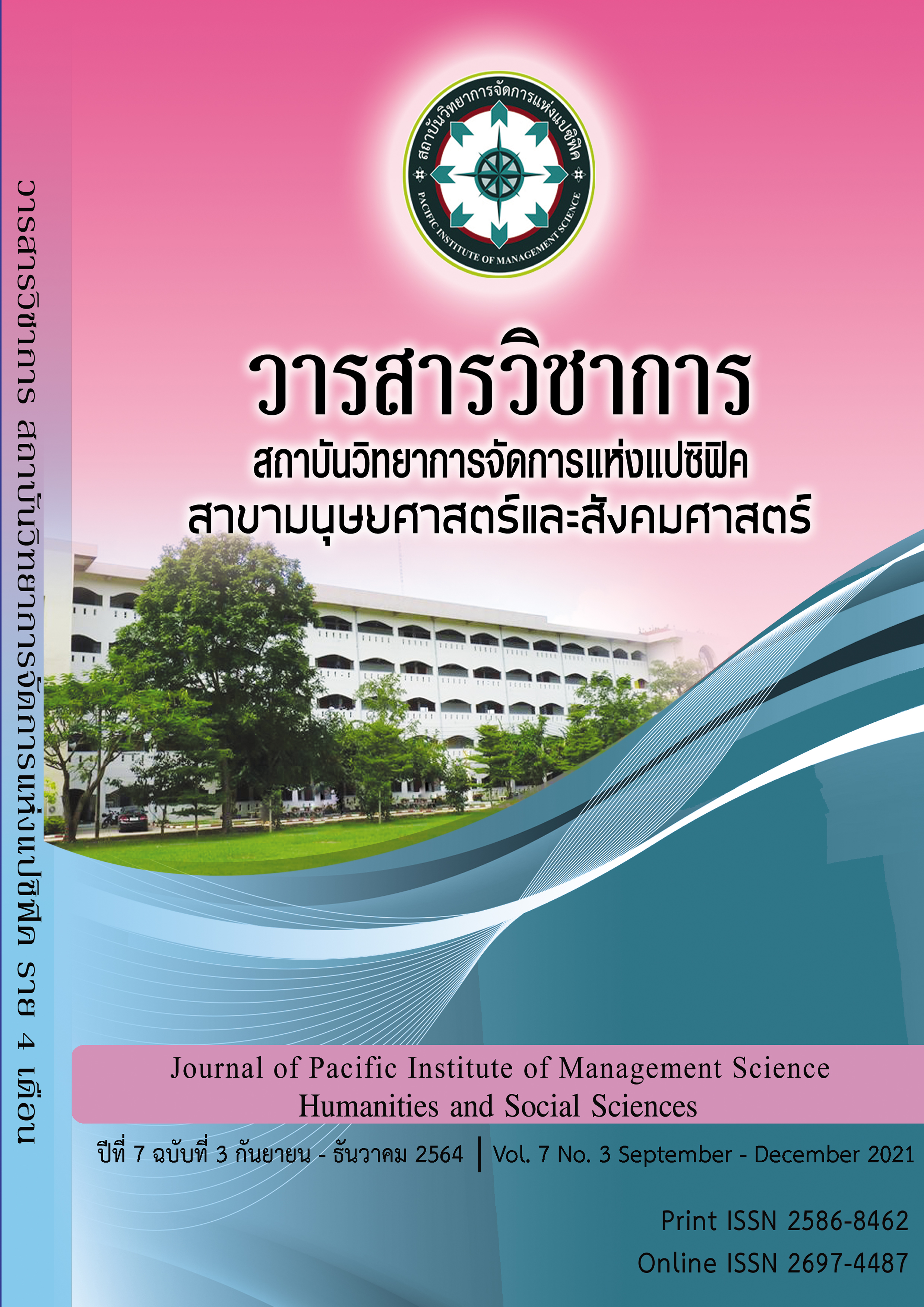Effectiveness of Adolescent Male Smoking Prevention Program in Educational Institutions
Keywords:
Smoking Prevention Program, Adolescent Male, Educational InstitutionsAbstract
This quasi-experimental research aimed to examine the effectiveness of adolescent male smoking prevention program in educational institutions. Study subjects were adolescent male age 18-19 year old in educational institutions Pathumthani Province. The sample comprised 70 subjects divided into two groups: an experimental and a control group of 35 subjects by August to September 2021. The researcher instrument consisted of 1) the adolescent male smoking prevention program in educational institutions, 2) Self-efficacy questionnaire on smoking prevention, 3) the non-smoking outcomes expectations questionnaire and 4) anti-smoking behavior questionnaire. The reliability of the three questionnaire were at 0.90, 0.88 และ 0.86 using Cronbach's Alpha Coefficient. The data were analyzed using paired and independent t-tests.
The results revealed that: the average scores of expectation on outcomes of non-smokers, and the mean scores of self-efficacy in preventing smoking of the experimental group were higher than the pretest group and higher than the control group were statistically significant at .05, and the average scores of anti-smoking behaviors of the trial group after 4 weeks of follow-up were higher than before and higher than the control group at a statistical significance of .05
Recommendations: Educational institutions should organize activities to enhance students' perceptions of their abilities and expectations for the outcomes of non-smoking. This will result in more effective smoking prevention behaviors.
References
กมลภู ถนอมสัตย์.(2554).ปัจจัยที่สัมพันธ์กับการสูบบุหรี่ในระยะเริ่มต้นของนักเรียนชายชั้นมัธยมศึกษาตอน สังกัดสำนักงานเขตพื้นที่การศึกษาตราด.วิทยานิพนธ์พยาบาลศาสตร มหาบัณฑิต สาขาการพยาบาลเวชปฏิบัติชุมชน คณะพยาบาลศาสตร์ บัณฑิตวิทยาลัย มหาวิทยาลัยบูรพา.
จิราพร สุวะมาตย์, สุนีย์ ละกำปั่น และสุรินธร กลัมพากร. (2558). ผลของโปรแกรมป้องกันการสูบบุหรี่สำหรับวัยรุ่นชายตอนต้นในสถานสงเคราะห์เด็กชาย. วารสารพยาบาล. 64(1), 1-11
โชคชัย สาครพานิช.(2554).ปัจจัยที่สัมพันธ์กับการตั้งใจสูบบุหรี่ของนักเรียนชายที่ไม่สูบบุหรี่ ชั้นมัธยมศึกษาตอนปลายโรงเรียนเขาสมิงวิทยาคม จังหวัดตราด.วารสารศูนย์การศึกษาแพทยศาสตร์คลินิก โรงพยาบาลพระปกเกล้า.28, 44-52.
นวลจิรา จันระลักษณะ, ทัศนา ทวีคูณ และโสภิณ แสงอ่อน. (2558). ปัจจัยทำนายการสูบบุหรี่ในนักเรียนมัธยมศึกษาตอนปลาย. รามาธิบดีพยาบาลสาร 2558; 29(2): 129-143.
บุญใจ ศรีสถิตย์นรากูร. (2550). ระเบียบการวิจัยทางพยาบาลศาสตร์ (พิมพ์ครั้งที่ 4). กรุงเทพฯ: จุฬาลงกรณ์มหาวิทยาลัย.
ประกิต วาทีสาธกกิจ. (2554). มาตรการในการควบคุมและป้องกันการสูบบุหรี่.ค้นเมื่อวันที่ 9 เมษายน 2564 . จาก http:// www.ashthailand.or.th. (2557).ข้อมูลสำคัญเรื่องบุหรี่กับเยาวชน.ค้นเมื่อวันที่ 27 เมษายน 2564 . จาก http:// www.ashthailand.or.th
โปรยทิพย์ สันตะพัน, ศิริญพร บุสหงส์, เชาวลิต ศรีเสริม.การสูบบุหรี่ในวัยรุ่น: บทบาทพยาบาล.Kuakarun Journal of Nursing 2019; 26 (1): 187 -199.
โสภิดา ทิพย์สวัสดิ์ เพลินพิศ ฐานิวัฒนานนท์ และอาภรณ์ทิพย์ บัวเพ็ชร์. (2563). ผลของโปรแกรมปรับเปลี่ยนพฤติกรรมเพื่อการเลิกบุหรี่ต่อการเลิกบุหรี่ของกลุ่มเสี่ยงโรคหัวใจและหลอดเลือด. วารสารพยาบาลศาสตร์และสุขภาพ.43(3). 135 - 147
มะลิสา งามศรี, นิตยา ตากวิริยนันท์, ศุภรา เชาว์ปรีชา. ผลของโปรแกรมการบำบัดการสูบบุหรี่ของวัยรุ่นในศูนย์ฝึกอบรมเด็กและเยาวชนในเขตภาค ตะวันออกเฉียงเหนือ. วารสารพยาบาลสาร 2557; 41(4): 36-47.
สำนักงานสถิติแห่งชาติ. (2561). การสำรวจพฤติกรรมการสูบบุหรี่และการดื่มสุราของประชากร พ.ศ. 2560. กรุงเทพฯ :พิมพ์ดีการพิมพ์.
Bandura, A. (1997). Self-efficacy: The exercise of control. New York: W.H. Freeman.
Bandura, A. (1977). Social learning theory. America: Englewood Cliffs, NJ: Prentice-Hall.
Bandura, A. (1989). Social Cognitive Theory. In R. Vasta (Ed.), Annals of Child Development. Six Theories of Child Development. 6: 1-60.
Pender, N.J. (2006). Health promotion in nursing practice. 3rd ed. Connecticut: Appleton & Lange.
Faul, F., Erdfelder, E., Buchner, A., Lang, A.-G. (2009). Statistical power analyses using G*Power 3.1: Tests for correlation and regression analyses. Behavior Research Methods, 41, 1149-1160.
Teja Z, Kimbery A, Reichl S. (2013). Peer relations of Chinese adolescent newcomer: Relations of peer group integration and friendship quality to psychological and school adjustment. Journal of International Migration and Integration.14: 535-556.
Downloads
Published
Issue
Section
License
Copyright (c) 2022 Pacific Institute of Management Science

This work is licensed under a Creative Commons Attribution-NonCommercial-NoDerivatives 4.0 International License.
บทความที่ได้รับการตีพิมพ์เป็นลิขสิทธิ์ของ สถาบันวิทยาการจัดการแห่งแปซิฟิค
ข้อความที่ปรากฏในบทความแต่ละเรื่องในวารสารวิชาการเล่มนี้เป็นความคิดเห็นส่วนตัวของผู้เขียนแต่ละท่านไม่เกี่ยวข้องกับสถาบันวิทยาการจัดการแห่งแปซิฟิค และคณาจารย์ท่านอื่นๆในสถาบันฯ แต่อย่างใด ความรับผิดชอบองค์ประกอบทั้งหมดของบทความแต่ละเรื่องเป็นของผู้เขียนแต่ละท่าน หากมีความผิดพลาดใดๆ ผู้เขียนแต่ละท่านจะรับผิดชอบบทความของตนเองแต่ผู้เดียว







